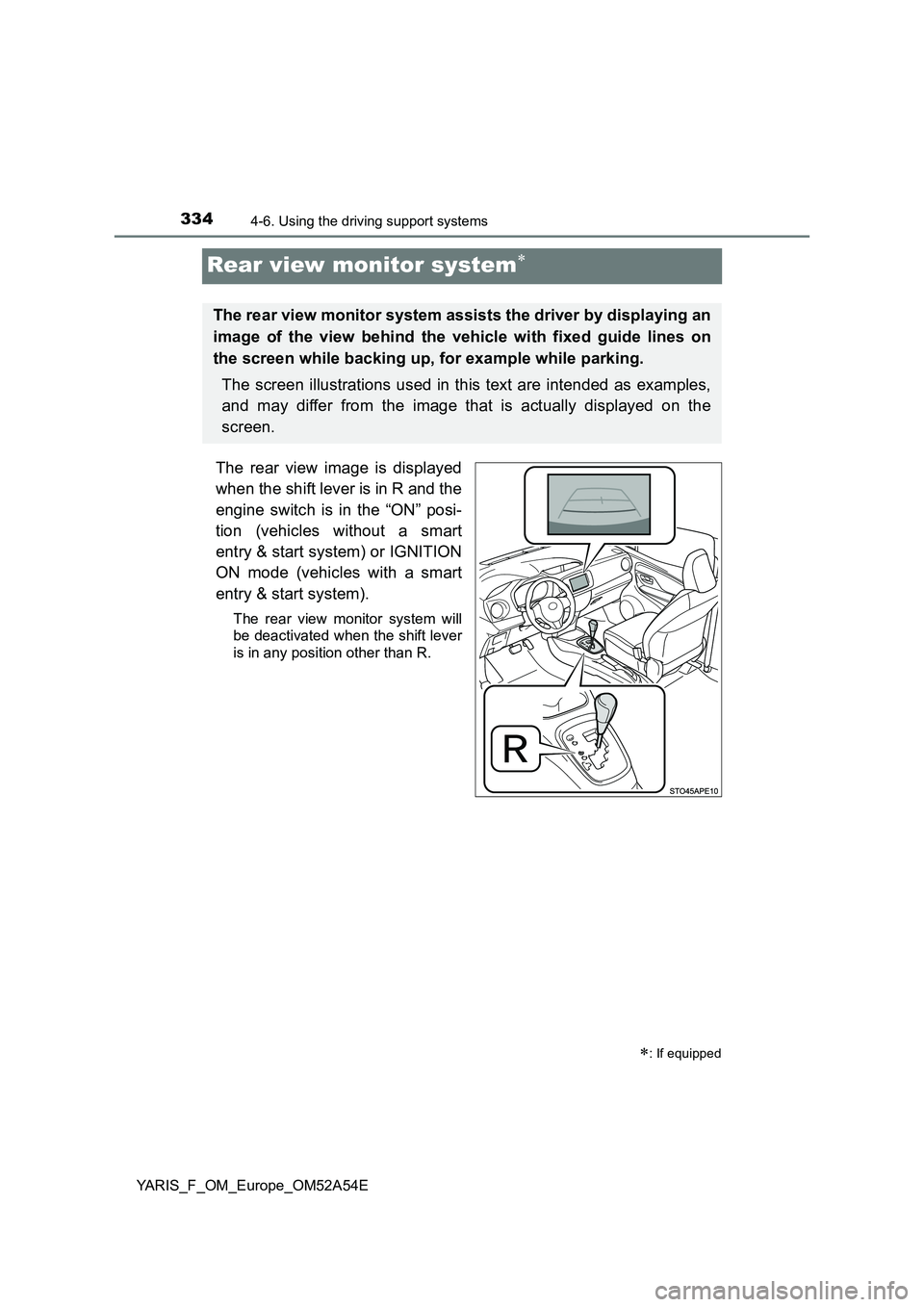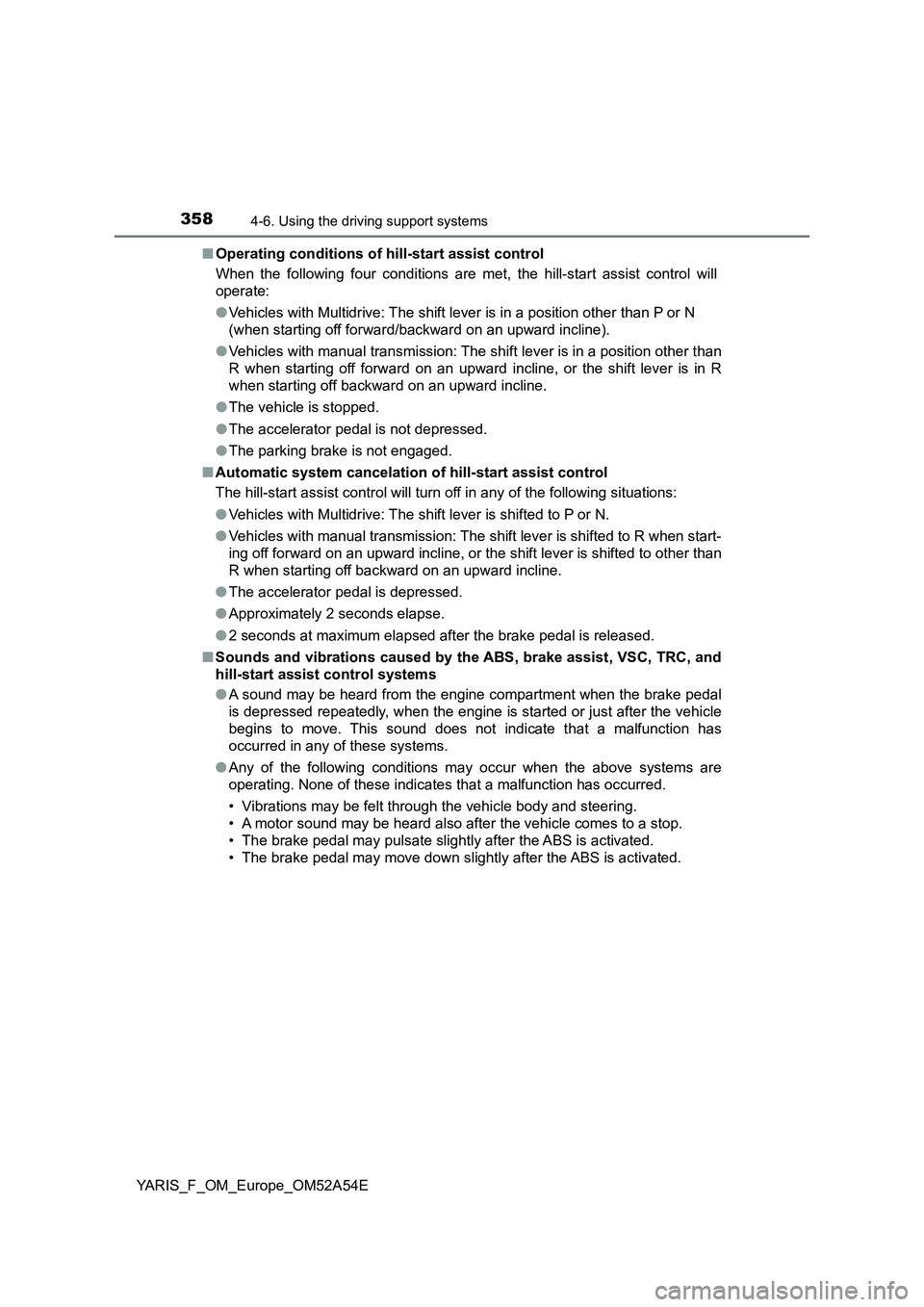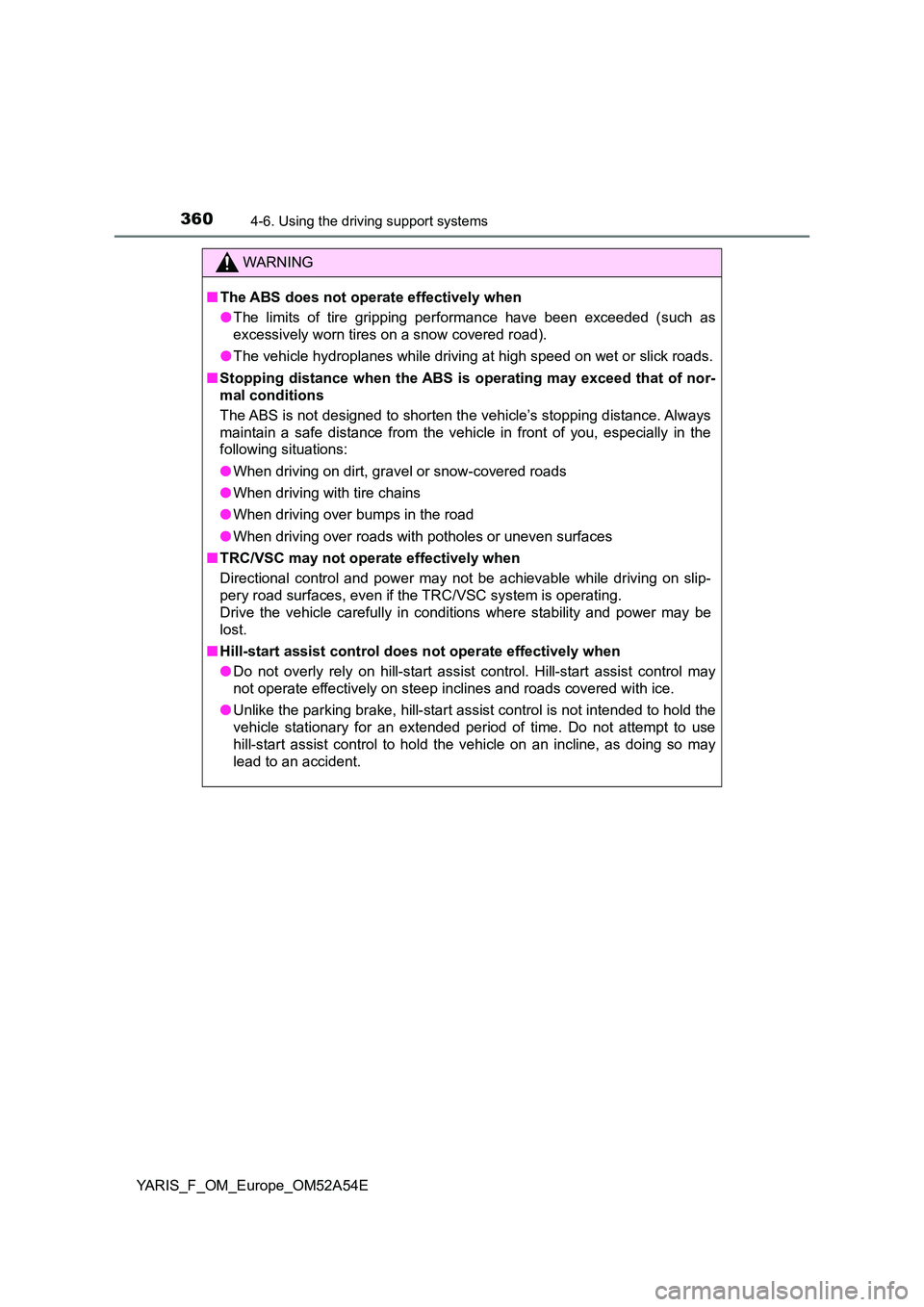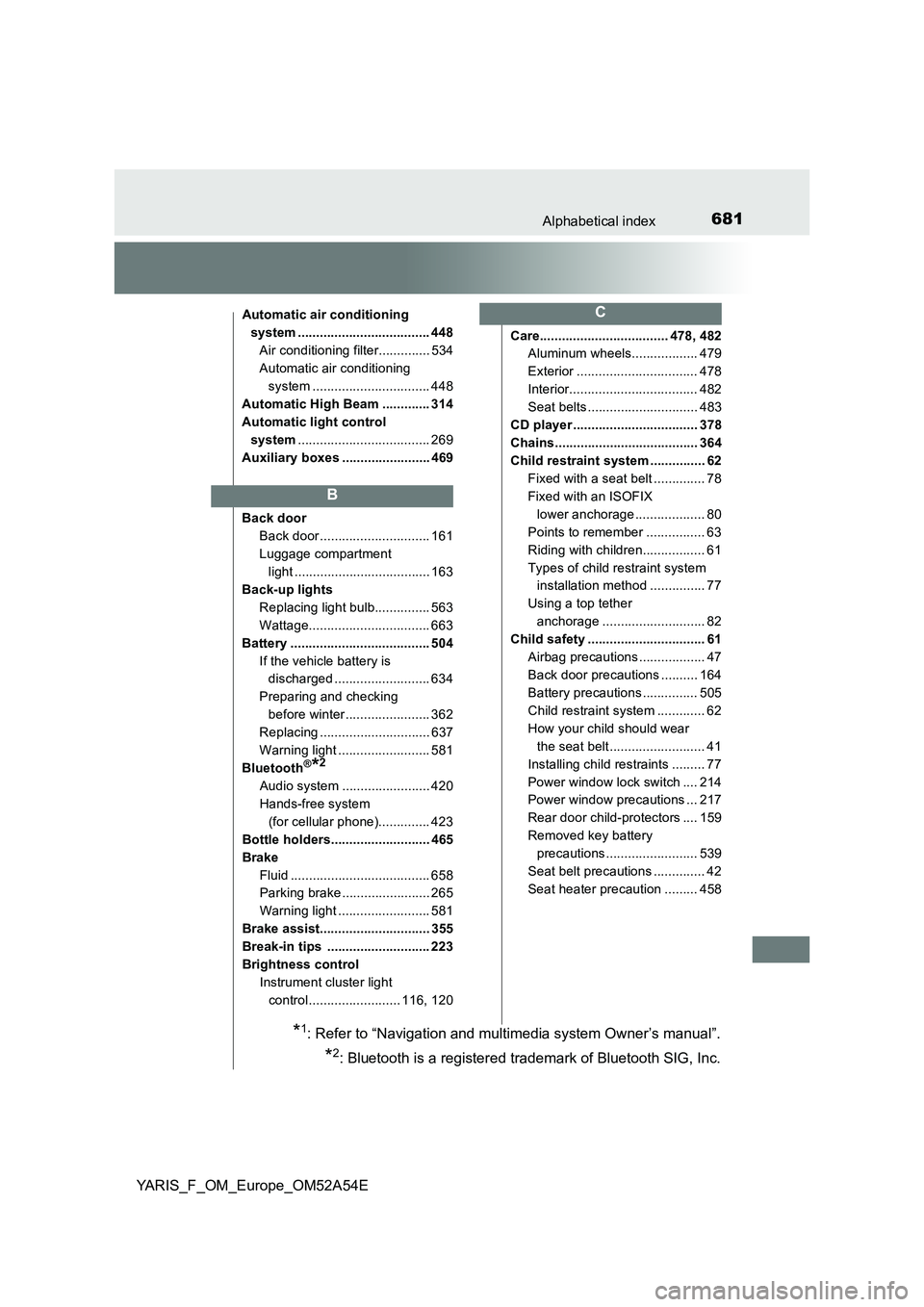2019 TOYOTA YARIS HATCHBACK park assist
[x] Cancel search: park assistPage 219 of 692

219
4Driving
YARIS_F_OM_Europe_OM52A54E4-1. Before driving
Driving the vehicle ............. 220
Cargo and luggage ............ 230
Trailer towing ..................... 231
4-2. Driving procedures
Engine (ignition) switch
(vehicles without
a smart entry &
start system) .................... 241
Engine (ignition) switch
(vehicles with
a smart entry &
start system) .................... 243
Multidrive ........................... 252
Manual transmission.......... 260
Turn signal lever ................ 264
Parking brake .................... 265
4-3. Operating the lights
and wipers
Headlight switch ................ 266
Fog light switch .................. 271
Windshield wiper and
washer ............................. 273
Rear window wiper and
washer ............................. 2774-4. Refueling
Opening the fuel tank
cap ................................... 279
4-5. Toyota Safety Sense
Toyota Safety Sense ......... 282
PCS
(Pre-Crash Safety
system) ............................ 290
LDA
(Lane Departure Alert) ..... 307
Automatic High Beam ........ 314
RSA (Road Sign Assist)..... 319
4-6. Using the driving support
systems
Cruise control..................... 325
Speed limiter ...................... 329
Rear view
monitor system ................ 334
Stop & start system............ 344
Driving assist systems ....... 355
4-7. Driving tips
Winter driving tips .............. 362
Page 227 of 692

2274-1. Before driving
4
Driving
YARIS_F_OM_Europe_OM52A54E
WARNING
●Do not attach adhesive discs to the windshield or windows. Do not place
containers such as air fresheners on the instrument panel or dashboard.
Adhesive discs or containers may act as lenses, causing a fire in the vehi-
cle.
● Do not leave a door or window open if the curved glass is coated with a
metallized film such as a silver-colored one. Reflected sunlight may cause
the glass to act as a lens, causing a fire.
● On vehicles with a Multidrive, always apply the parking brake, shift the
shift lever to P, stop the engine and lock the vehicle.
Do not leave the vehicle unattended while the engine is running.
If the vehicle is parked with the shift lever in P but the parking brake is not
set, the vehicle may start to move, possibly leading to an accident.
● Do not touch the exhaust pipes while the engine is running or immediately
after turning the engine off.
Doing so may cause burns.
■ When taking a nap in the vehicle
Always turn the engine off. Otherwise, if you accidentally move the shift
lever or depress the accelerator pedal, this could cause an accident or fire
due to engine overheating. Additionally, if the vehicle is parked in a poorly
ventilated area, exhaust gases may collect and enter the vehicle, leading to
death or a serious health hazard.
■ When braking
● When the brakes are wet, drive more cautiously.
Braking distance increases when the brakes are wet, and this may cause
one side of the vehicle to brake differently than the other side. Also, the
parking brake may not securely hold the vehicle.
● If the brake booster device does not operate, do not follow other vehicles
closely and avoid hills or sharp turns that require braking.
In this case, braking is still possible, but the brake pedal should be
depressed more firmly than usual. Also, the braking distance will increase.
Have your brakes fixed immediately.
● Do not pump the brake pedal if the engine stalls.
Each push on the brake pedal uses up the reserve for the power-assisted
brakes.
● The brake system consists of 2 individual hydraulic systems; if one of the
systems fails, the other will still operate. In this case, the brake pedal
should be depressed more firmly than usual and the braking distance will
increase. Have your brakes fixed immediately.
Page 334 of 692

3344-6. Using the driving support systems
YARIS_F_OM_Europe_OM52A54E
Rear view monitor system
The rear view image is displayed
when the shift lever is in R and the
engine switch is in the “ON” posi-
tion (vehicles without a smart
entry & start system) or IGNITION
ON mode (vehicles with a smart
entry & start system).
The rear view monitor system will
be deactivated when the shift lever
is in any position other than R.
: If equipped
The rear view monitor system assists the driver by displaying an
image of the view behind the vehicle with fixed guide lines on
the screen while backing up, for example while parking.
The screen illustrations used in this text are intended as examples,
and may differ from the image that is actually displayed on the
screen.
Page 342 of 692

3424-6. Using the driving support systems
YARIS_F_OM_Europe_OM52A54E
WARNING
■When using the rear view monitor system
The rear view monitor system is a supplemental device intended to assist
the driver when backing up. When backing up, be sure to visually check all
around the vehicle both directly and using the mirrors before proceeding.
Observe the following precautions to avoid an accident that could result in
death or serious injuries.
● Never depend on the rear view monitor system entirely when backing up.
The image and the position of the guide lines displayed on the screen may
differ from the actual state.
Use caution, just as you would when backing up any vehicle.
● Be sure to back up slowly, depressing the brake pedal to control vehicle
speed.
● The instructions given are only guide lines.
When and how much to turn the steering wheel will vary according to traf-
fic conditions, road surface conditions , vehicle condition, etc. when park-
ing. It is necessary to be fully aware of this before using the rear view
monitor system.
● When parking, be sure to check that the parking space will accommodate
your vehicle before maneuvering into it.
● Do not use the rear view monitor system in the following cases:
• On icy or slick road surfaces, or in snow
• When using tire chains or emergency tires
• When the back door is not closed completely
• On roads that are not flat or straight, such as curves or slopes.
● In low temperatures, the screen may darken or the image may become
faint. The image could distort when the vehicle is moving, or you may
become unable to see the image on the screen. Be sure to visually check
all around the vehicle both directly and using the mirrors before proceed-
ing.
● If the tire sizes are changed, the position of the fixed guide lines displayed
on the screen may change.
● The camera uses a special lens. The distances between objects and
pedestrians that appear in the image displayed on the screen will differ
from the actual distances. ( P. 337)
Page 358 of 692

3584-6. Using the driving support systems
YARIS_F_OM_Europe_OM52A54E■Operating conditions of hill-start assist control
When the following four conditions are met, the hill-start assist control will
operate:
●Vehicles with Multidrive: The shift lever is in a position other than P or N
(when starting off forward/backward on an upward incline).
●Vehicles with manual transmission: The shift lever is in a position other than
R when starting off forward on an upward incline, or the shift lever is in R
when starting off backward on an upward incline.
●The vehicle is stopped.
●The accelerator pedal is not depressed.
●The parking brake is not engaged.
■Automatic system cancelation of hill-start assist control
The hill-start assist control will turn off in any of the following situations:
●Vehicles with Multidrive: The shift lever is shifted to P or N.
●Vehicles with manual transmission: The shift lever is shifted to R when start-
ing off forward on an upward incline, or the shift lever is shifted to other than
R when starting off backward on an upward incline.
●The accelerator pedal is depressed.
●Approximately 2 seconds elapse.
●2 seconds at maximum elapsed after the brake pedal is released.
■Sounds and vibrations caused by the ABS, brake assist, VSC, TRC, and
hill-start assist control systems
●A sound may be heard from the engine compartment when the brake pedal
is depressed repeatedly, when the engine is started or just after the vehicle
begins to move. This sound does not indicate that a malfunction has
occurred in any of these systems.
●Any of the following conditions may occur when the above systems are
operating. None of these indicates that a malfunction has occurred.
• Vibrations may be felt through the vehicle body and steering.
• A motor sound may be heard also after the vehicle comes to a stop.
• The brake pedal may pulsate slightly after the ABS is activated.
• The brake pedal may move down slightly after the ABS is activated.
Page 360 of 692

3604-6. Using the driving support systems
YARIS_F_OM_Europe_OM52A54E
WARNING
■The ABS does not operate effectively when
● The limits of tire gripping performance have been exceeded (such as
excessively worn tires on a snow covered road).
● The vehicle hydroplanes while driving at high speed on wet or slick roads.
■ Stopping distance when the ABS is operating may exceed that of nor-
mal conditions
The ABS is not designed to shorten t he vehicle’s stopping distance. Always
maintain a safe distance from the vehicle in front of you, especially in the
following situations:
● When driving on dirt, gravel or snow-covered roads
● When driving with tire chains
● When driving over bumps in the road
● When driving over roads with potholes or uneven surfaces
■ TRC/VSC may not operate effectively when
Directional control and power may not be achievable while driving on slip-
pery road surfaces, even if the TRC/VSC system is operating.
Drive the vehicle carefully in conditions where stability and power may be
lost.
■ Hill-start assist control does not operate effectively when
● Do not overly rely on hill-start assist control. Hill-start assist control may
not operate effectively on steep inclines and roads covered with ice.
● Unlike the parking brake, hill-start assist control is not intended to hold the
vehicle stationary for an extended period of time. Do not attempt to use
hill-start assist control to hold the vehicle on an incline, as doing so may
lead to an accident.
Page 576 of 692

5768-2. Steps to take in an emergency
YARIS_F_OM_Europe_OM52A54E
Securely attach cables or chains to the towing eyelet.
Take care not to damage the vehicle body.
Vehicles without a smart entry & start system: Enter the vehicle
being towed and start the engine.
If the engine does not start, turn the engine switch to the “ON” position.
Vehicles with a smart entry & start system: Enter the vehicle being
towed and start the engine.
If the engine does not start, turn the engine switch to IGNITION ON mode.
Shift the shift lever to N and release the parking brake.
When the shift lever cannot be shifted: P. 2 5 7
■While towing
If the engine is not running, the power assist for the brakes and steering will
not function, making steering and braking more difficult.
■ Wheel nut wrench
● Vehicles with a wheel nut wrench: Wheel nut wrench is installed in the lug-
gage. ( P. 599, 615)
● Vehicles without a wheel nut wrench: Wheel nut wrench can be purchased
at any authorized Toyota retailer or Toyota authorized repairer, or any reli-
able repairer.
5
6
7
Page 681 of 692

681Alphabetical index
YARIS_F_OM_Europe_OM52A54E
Automatic air conditioning
system .................................... 448
Air conditioning filter.............. 534
Automatic air conditioning
system ................................ 448
Automatic High Beam ............. 314
Automatic light control
system.................................... 269
Auxiliary boxes ........................ 469
Back door
Back door .............................. 161
Luggage compartment
light ..................................... 163
Back-up lights
Replacing light bulb............... 563
Wattage................................. 663
Battery ...................................... 504
If the vehicle battery is
discharged .......................... 634
Preparing and checking
before winter....................... 362
Replacing .............................. 637
Warning light ......................... 581
Bluetooth
®*2
Audio system ........................ 420
Hands-free system
(for cellular phone).............. 423
Bottle holders........................... 465
Brake
Fluid ...................................... 658
Parking brake ........................ 265
Warning light ......................... 581
Brake assist.............................. 355
Break-in tips ............................ 223
Brightness control
Instrument cluster light
control......................... 116, 120Care................................... 478, 482
Aluminum wheels.................. 479
Exterior ................................. 478
Interior................................... 482
Seat belts .............................. 483
CD player .................................. 378
Chains....................................... 364
Child restraint system ............... 62
Fixed with a seat belt .............. 78
Fixed with an ISOFIX
lower anchorage ................... 80
Points to remember ................ 63
Riding with children................. 61
Types of child restraint system
installation method ............... 77
Using a top tether
anchorage ............................ 82
Child safety ................................ 61
Airbag precautions .................. 47
Back door precautions .......... 164
Battery precautions ............... 505
Child restraint system ............. 62
How your child should wear
the seat belt.......................... 41
Installing child restraints ......... 77
Power window lock switch .... 214
Power window precautions ... 217
Rear door child-protectors .... 159
Removed key battery
precautions......................... 539
Seat belt precautions .............. 42
Seat heater precaution ......... 458
B
C
*1: Refer to “Navigation and multimedia system Owner’s manual”.
*2: Bluetooth is a registered trademark of Bluetooth SIG, Inc.